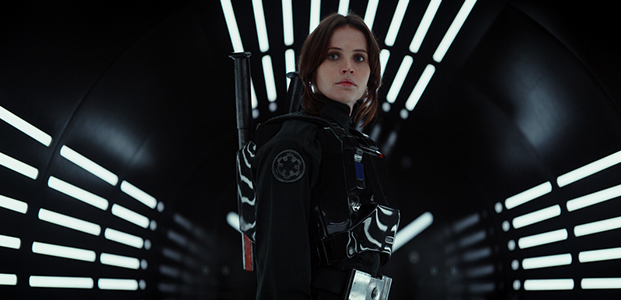
Rogue One represents the best kind of imagined Star Wars fan fiction come to life. The first of a planned series of standalone stories set in the fictional universe far, far away, it promises great things for the mighty franchise, even if it has trouble getting off the ground initially.
The story of Rogue One has been told numerous times before with different variations, most recently in Valkyrie. A rag tag group of individuals with a common purpose get together to plan and execute an impossible mission. This setup may seem odd for the Lucas saga, but if you consider the films positioning as the prequel to A New Hope it makes sense. The backdrop to the setup is the still under development Death Star and the man behind its creation, Galen Erso, who, despite his best efforts to distance himself from the Imperial army, is sucked back into their fold after being captured during the opening moments. Many years later, his estranged daughter Jyn (because Star Wars is always filial), who he abandoned to ensure her safety, grows up with guerilla rebel leader Saw Gerrera (modeled it seems, rather unimaginatively, on Che Guevara) and is picked to lead a rebel insurrection. After a tedious turn of events, which sees her planet hopping across the galaxy, Jyn finds herself sharing a spaceship (the titular Rogue One) with a group who believe that together they can stop the Death Star before it is put to lethal use against the Rebel Alliance.
Given the challenge of being a Star Wars film but almost completely devoid of any familiar faces or characters (with a few notable exceptions, largely relegated to surprise cameos or easter eggs), Rogue One struggles to get into groove early on. Felicity Jones is merely functional in her lead role despite being given the most screen time and backstory. The remaining members are hastily introduced in quick succession and the proceedings them move to the next stage – team formation when they work together as an effective (if not altogether memorable) unit. Whereas last year’s The Force Awakens had a racially diverse cast, here they are cross-culturally hand picked from all over the globe. As a result, the film’s energy is derived mostly from scenes where the focus is on them as a whole rather than on individuals. And once it gets to this stage, the results are glorious. If the first two acts are the long, slow build-up, the third is the solid, energetic payoff featuring a grand space fight intercut to tense scenes of ground battle that are some of the best in the series. You’ve seen the Death Star used on planets before, but not the way it’s shown here. The results onscreen are both majestically glorious and frighteningly horrific, befittingly earning it the nickname Planet Destroyer.
When it becomes clear where the film is headed and the outcome logically inevitable, Rogue One finally finds itself freed of the shackles of lore and continuity, something it should have done sooner and more of. In contrast to Force Awakens, it also lacks the important mix of heart, energy and wit that J.J. Abrams had infused to that film. Director Gareth Edwards however bring his unique skills to the table; his trademark manner of building scale and slowly pulling back to show the full perspective (also in display in the very weak Godzilla remake) which aids with the massive build up during the final battle. Rogue One gets off to an imperfect start but the payoff is spectacular and climatic standoff perilous enough for viewers to quietly intone, “May the force be with them”.
Rating: 



